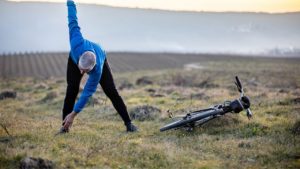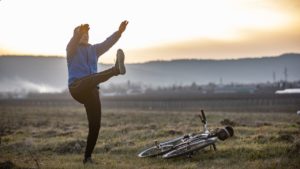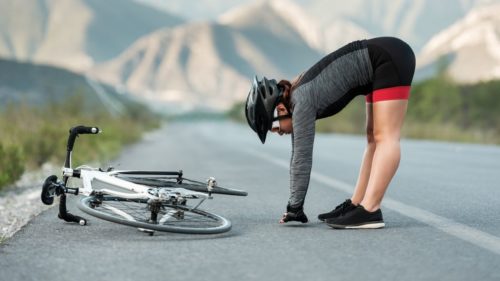When it is time to go on a bike ride, so many people just want to jump right on and get going. However, the smart thing is to do a proper warm-up, and even do some light stretching to get the body ready to go.
Below are some of the best stretching exercises to take under consideration before going on a trip. It does not have to be anything too strenuous, as people can see what works for them and what does not. Ultimately, doing something before really pushing the pace as a cyclist will help the body respond the way it should.
1. Leg Swings
Having the hips work properly is going to be a huge part of cycling in the right way. Hips can get very tight if they are not loosened up before a ride, so try to work on hip flexor mobility as much as possible.
For a leg swing exercise, start with standing on the inside leg, and holding something for stability. People who are already out and about with their bike can do exactly that with the seat of the bike itself.
The outside leg needs to swing forward and backward, and it should be straight or very slightly bent at all times. Start out slowly since this is a bit of a warm-up, but extend the swing’s length during each swing.
Try to get up to as many as 10 times for a repetition. Make sure to swing the leg from both sides, and also focus on both legs as well. This is a pretty simple stretch that can get the blood going as well, which is all that a lot of people really need to get going as a cyclist.
2. Quad Stretch
The quads are where so much power comes from when a person is cycling and trying to get faster and faster times all the time.
In particular, quads will be very important when out of the saddle and trying to power up certain hills. To really start to extend how to ride consistently, getting the quads stretched out is crucial overall.
The most basic quad stretch is simply standing straight up, and pulling one leg up at the knee to the butt. People will feel the quad stretch right away, and the range of motion will start to open up a bit as well.
This is really the only type of stretch a person needs to do if they are riding, because everything else will start to loosen up with the other stretches.
Quads might not seem like they need that much work overall, but never neglect them either. It takes a little bit of a tweak with the quad muscles for people to feel like they are very limited on their riding ability.
It is the last thing a person wants to have to deal with if they are trying to really up their mileage.
3. Hamstring Stretch
The hamstrings are one of the most important parts of cycling. People will feel that extension and retention action with their hamstrings every single pedal, and having strong hamstrings will increase pedaling efficiency and overall power.
Even when a person is out of the saddle, there will be many benefits of having strong hamstrings. Because of that, it is important to strengthen them before and after.
The simplest form of a hamstring stretch can be to put one leg out in front of the other, with the front leg’s heel on the ground.
Then, a person is extending their arms towards that front leg, trying to reach the toes to get a proper hamstring stretch. People will feel it in their legs, and they can hold it for a little bit before letting go.
There is also the option of stretching the hamstring out when laying on the ground. This might be easier for people looking to get a bit more variety, as they can even use large rubber bands to help. It all comes down to what works best for a person, and just how tight the hamstrings are.
Longer hamstrings are going to be very beneficial for anyone who is riding consistently. It makes a lot of sense to put in the effort so that they are extending a bit and feel like they are ready to go for any type of ride in the future.
4. Foam Rolling
Using a foam roller for different parts of the body is a great way to stretch out in so many different ways. People have fallen in love with foam rollers over the last few years, and it is a pretty gentle way of getting all the muscles loosened up in a way that makes sense.
Foam rolling takes a little bit of time, and most people need to find a softer area so that they can roll around on the ground as well.
Not everyone has a foam roller at their disposal, which is why they do not always use a foam roller before heading out on a ride.
Those who have the opportunity should use them, because they come in handy for people who might have any aches or pains before starting.
With a foam roller, so many different areas can be focused on. It also helps quite a bit because people can release tension if they are dealing with any type of soreness.
Whether it is muscle soreness, range of motion, or any other limitations, just going for 10 minutes at a time can give a person the deep tissue massage they are looking for.
5. Chest Stretch
The chest is one of the most overlooked parts of the body when getting ready to ride for long periods of time. Everyone thinks so much about the legs, but the chest needs to be stretched out since it will be moving around quite a bit.
Make sure to do the proper chest stretches necessary to open things up and make everything feel a lot more flexible overall.
It is best to do chest stretches after some form of cardio has loosened the rest of the body up just a bit. Some people try to do some basic chest stretches when they are very cold, and it is not going to really be that effective at all.
The last thing a person wants to do is put themselves in a situation where they are not getting a good stretch because they did not get the rest of their body prepared.
6. Lunges
Lunges can be divided into so many different types of exercises. In particular, walking lunges or sidestep lunges will help out cyclists trying to isolate the hamstrings and quads before starting.
While it is essential to work on hamstrings when a person is about to go on a run, it makes a lot of sense to focus on the hamstrings before a biking experience as well.
Walking lunges are going to be when a person stands very tall on their feet at shoulder length. Take a step forward into a lunge while bending the knee to lower the hips pretty well.
Push the weight on the back foot to the front to really make the stretch feel a certain way. Alternate between the two legs, and it will resemble a walk in many ways.
To do a side step lunge, start in the same standing tall position. Step to the left or the right to bend into the lunge and start to feel the stretch pretty well.
People will notice right away that there is something different with this type of lunge, and they will try to get more and more exercise in that regard.
It is important when doing lunges to take it easy early on. A person can do quite a bit of damage if they have not done any proper warm-up beforehand. Do not try to go straight into doing deep lunges, or it might actually do more harm than good.
7. Butt Kicks
The thighs and butt muscles benefit the most from butt kicks, but people notice that they get a stretch with their hip flexor and hamstrings as well.
This is something that people use to get ready for all types of cardio exercise, and people who have tight hamstrings need to make sure that they always have this as part of the regimen.
When a person has stronger hamstrings, they can increase their cycle speed overall. Doing butt kicks can also strengthen the glutes and quads to be ready for pretty rapid, steady movement.
There are ways to do butt kicks by standing in one position or running up and down and getting some cardio in that way. As with all these leg stretches, it helps to switch to either side on repeat so that everything gets the type of workout that it needs.
8. High Knees
The great thing about doing high knees is that there is a way to get the blood going at the same time as getting a good overall stretch.
There are a lot of people who get a very good workout from doing high knees before having a chance to hit the trail. It can be extremely beneficial, and he does not take a lot of effort to get going.
Maybe the only thing to remember is to ensure that the knees get up high enough to feel the stretches. If a person wants to start by just walking and pulling your knees up to exaggerate the motion, they can do that as well.
Eventually, people like to get almost a sprint in by moving their knees quickly and as high as they can. This will stretch out most of the leg at once, and get people prepared to hit the trail the way they want.
9. Glute and Hip Flexor Stretch
When a person will go on a ride and sit for quite a long time, the glutes and hip flexors need to be stretched properly.
The best way to do that is to do some simple stretches that involve crossing the legs up so that the lower back, the butt, and the hip flexors are properly loosened up and ready to go.
To start out with a simple stretch, lay on the ground. Pull the legs up, and cross one leg over the top of the other so that the leg doing the crossing has the glutes and hip flexors stretched out. Hold that position for up to 30 seconds, and then switch directions.
The stretch is great for not only before a ride, but after as well. Nobody wants to be in a situation where they have glutes or hip flexors that are severely sore.
It can lead to some problems that take a long time to go away, and it can get in the way of riding as much as a person would like to.
10. Squats
Squats are a great exercise for people who want to build up stronger legs overall, and cyclists have been doing them for quite some time.
It can also be done to get a great workout and build muscle, but some light squats with no weight are a great way to stretch the body out quite a bit.
Doing a proper squat takes a little bit of time, and people will perhaps struggle at first if they have never done it before. Try to start by going as deep as possible with the squat early on, but not everyone will get that deep push that they are hoping for.
It takes a little bit of strength as well as balance to have everything go as it should. Eventually, people start to see progress, even if it means being a bit sore after the fact.
Keys to Pre Cycling Exercises
Before getting going with pre-cycling exercises and stretches, it is important to keep a few general tips in mind. Most people have a pretty good idea of what to expect out of exercising and getting the blood going.
Still, some general knowledge can help considerably for those who might be trying to build up their cycling ability.
1. Hold Stretches for at Least 30 Seconds

Holding stretches for longer periods of time will help out considerably. This is to make sure that everything is not rushed in general.
They are too many people who try to rush through some of the stretches, and they really do not get much done at all. It can be very frustrating to go about it that way because they feel like it was generally a waste of time.
2. Warm-Up Lightly Before Stretching

There is really no sense at all in stretching cold muscles. For the body to respond properly, it needs to be warmed up so that the muscles are moving around.
To get loose, think about something very easy, yet is getting the body moving. Many people will go for a light jog, do something stationary like jumping jacks, or even go on a very early bike ride to get the body going.
What people notice is that their stretching goes a lot better with a proper warm-up. A person will not do too much damage to their body by warming up the smart way.
For those who are not warming their muscles up, the body does not react the way many are hoping for.
3. Remember to Stretch After as Well
Stretching in some ways before going on a bike ride is certainly beneficial. However, there are so many people out there who believe that the more important stretches come after the ride.
This is a way for the body to stay loose and feel like it can bounce back when all the stretching is done properly.
Treating muscles properly after a ride will improve the chances of a faster recovery. It does not necessarily have to be anything too crazy, and a lot of the same stretches can be done before and after.
Just make sure to budget the proper amount of time to do this instead of not caring for the body.
4. Don’t Be Afraid to Step Out of the Comfort Zone

It can feel like a very tedious, difficult step to adjust for people who have never been in the habit of stretching in the past. However, those who start to stretch out before and after a ride will be very happy with where their body stands as time goes on.
Some of the stretches will feel different and even awkward. Stick with it. Do not be afraid of moving away from the comfort zone to get a better overall feel.
Final Thoughts on a Quality Pre-Ride Stretch Routine
They will always be people out there who do not do much stretching beforehand, as they feel like they can start a little slower with cycling and build their way up.
However, the vast majority of people will recommend at least something to do before getting on the bike itself.
As a person starts to get up there in age, there is always that thought of needing to stretch out more and more. Do not overlook some of the simplest parts of a routine.
It might not seem like much, but putting in a little more effort with stretching and preparation will make cycling that much more enjoyable.
Even some of the minor injuries out there can end up setting a person back and not allowing them to have the type of fun they are hoping for.

